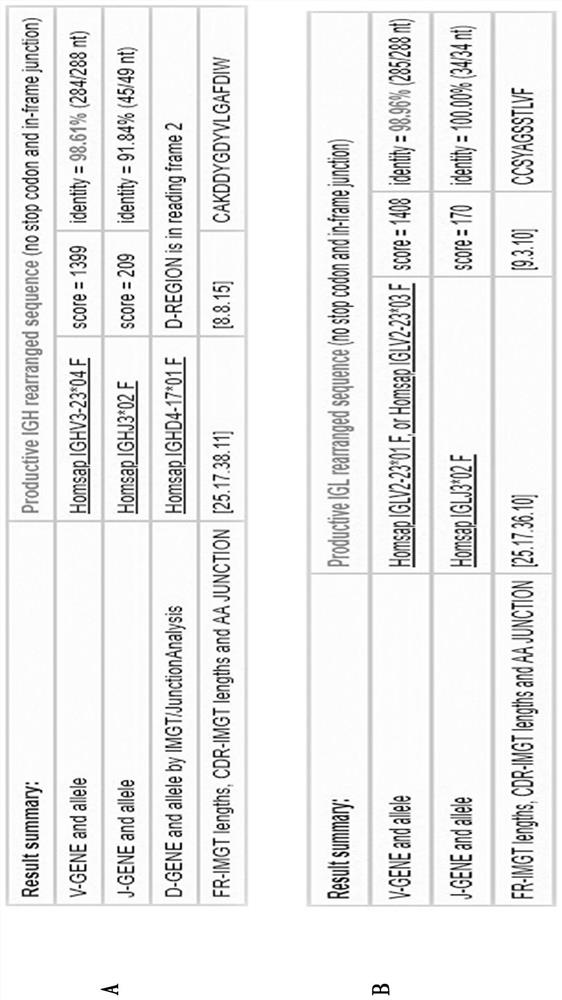Highly neutralizing active anti-sars-cov-2 fully human monoclonal antibody targeting rbd and its application
A monoclonal antibody, sars-cov-2 technology, applied in the field of microbiology and immunology, can solve the problem of not preventing coronavirus and achieve good neutralization protection effect, good stability and low immunogenicity
- Summary
- Abstract
- Description
- Claims
- Application Information
AI Technical Summary
Problems solved by technology
Method used
Image
Examples
Embodiment 1
[0028] Example 1 Screening and Preparation of Human Anti-SARS-CoV-2 Monoclonal Antibody
[0029] 1.1 Prepare a 96-well plate: 20 μl RNase-free water + 20U RNase inhibitor per well, cover the plate with a sealing film, and store at 4°C for later use
[0030] 1.2 Prepare samples:
[0031] (1) Resuscitating cells: Take out the frozen PBMC cells isolated from the peripheral blood of patients who have recovered from COVID-19 from -80°C, and quickly place them in warm water at 37°C. After the cells are thawed, centrifuge at 800rpm for 5 minutes, and discard the supernatant; Resuspend with 2-3ml FPBS into the flow tube, after balancing, centrifuge at 800rpm for 5min, pour off the supernatant; then resuspend with 2-3ml FPBS, centrifuge, and pour off the supernatant. Finally, 100 μl FPBS was added to resuspend, and 2 μl was drawn to dilute 10 times for cell counting.
[0032] (2) Single staining tube: 5 tubes (including FITC-labeled antigen, PE-labeled IgG, Alexa Fluor 700-labeled CD...
Embodiment 2
[0091] Example 2 Analysis of the binding activity of human-derived anti-SARS-CoV-2 monoclonal antibody 4B7 to S, S1, S2 and RBD
[0092] 2.1 Coating: Dilute the recombinant S antigen, S1 antigen, RBD antigen and S2 antigen with the coating solution to a concentration of 2 μg / mL, coat the microtiter plate, 100 μL per well, and coat overnight at 4 °C.
[0093] 2.2 Blocking: add 300 μL of PBST washing solution to each well, wash 3 times × 3 min each time; tap the liquid in the well, add 2% BSA, 200 μL / well, and block at 37°C for 1 hour.
[0094] 2.3 Sample incubation: add 300 μL PBST washing solution to each well, wash 3 times × 3min / time; clap the liquid in the well, add purified monoclonal antibody diluted in PBS, the first well 9ug / ml, 3-fold serial dilution 100 μL / well, 37 Incubate at ℃ for 1h.
[0095] 2.4 Secondary antibody incubation: wash, same as above; add HRP goat anti-human F C Secondary antibody (diluted 1:20000), 100 μL / well, incubated at 37°C for 1 hour.
[0096...
Embodiment 3
[0100] Example 3 Biacore T200 Determination of Affinity of Monoclonal Antigens to S, S1, and RBD Antigens
[0101] The basic principle of the assay is a biosensing analytical technique based on the physical optical phenomenon of surface plasmon resonance (SPR). Fluorescent and isotopic labels are not necessary, thereby maintaining the natural activity of biomolecules. When the incident light is incident on the interface of two different transparent media at the critical angle, total reflection will occur, and the intensity of the reflected light should be the same at all angles, but if a metal film is coated on the surface of the medium, the incident light can The resonance of the free electrons in the metal is caused, which causes the reflected light to be greatly weakened within a certain angle, and the angle at which the reflected light completely disappears is called the resonance angle. The resonance angle will change with the change of the refractive index of the liquid...
PUM
 Login to View More
Login to View More Abstract
Description
Claims
Application Information
 Login to View More
Login to View More - R&D
- Intellectual Property
- Life Sciences
- Materials
- Tech Scout
- Unparalleled Data Quality
- Higher Quality Content
- 60% Fewer Hallucinations
Browse by: Latest US Patents, China's latest patents, Technical Efficacy Thesaurus, Application Domain, Technology Topic, Popular Technical Reports.
© 2025 PatSnap. All rights reserved.Legal|Privacy policy|Modern Slavery Act Transparency Statement|Sitemap|About US| Contact US: help@patsnap.com



